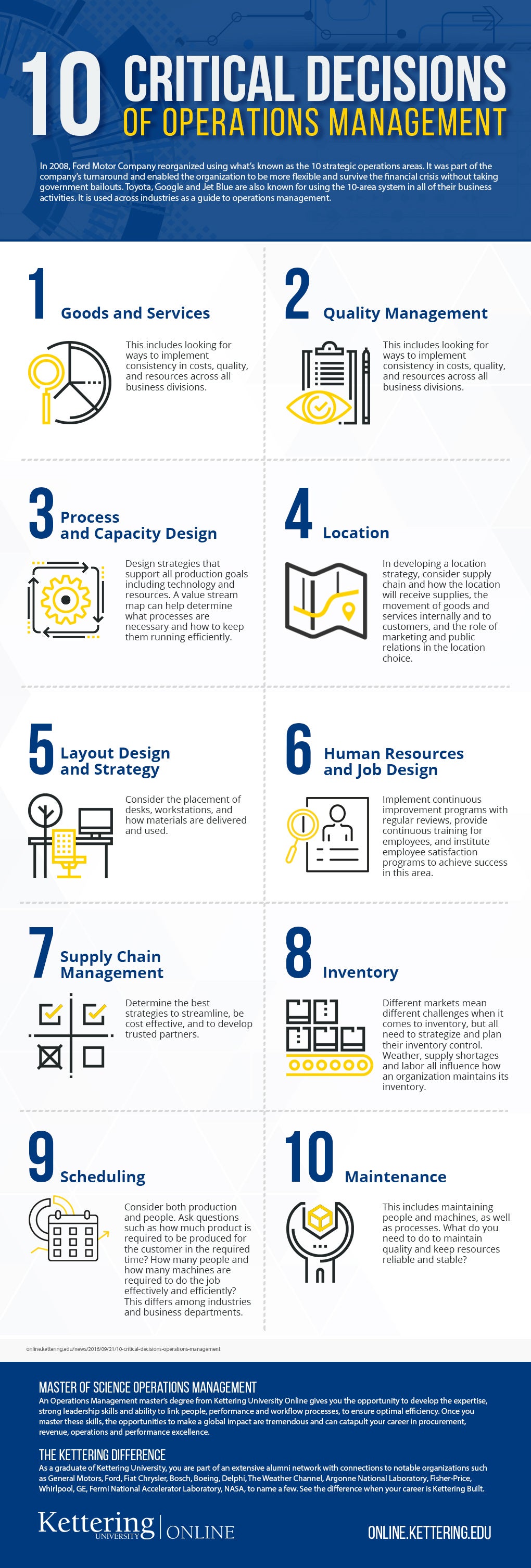
10 Critical Decisions of Operations Management
10 Strategic Operation Management Decisions
In 2008, Ford Motor Company reorganized using what’s known as the 10 strategic operations areas. It was part of the company’s turnaround and enabled the organization be more flexible and survive the financial crisis without taking government bailouts. Toyota, Google and Jet Blue are also known for using the 10 area system in all of their business activities. It is used across industries as a guide to operations management.
The areas are:
- Goods and services: This includes looking for ways to implement consistency in costs, quality, and resources across all business divisions.
- Quality Management: Be clear on the customer’s demands and then meet those expectations. Use market research to determine customer needs and batch quality assurance testing on products and services in production.
- Process and Capacity Design: Design strategies which support all production goals including technology and resources. A value stream map can help determine what processes are necessary and how to keep them running efficiently.
- Location: In developing a location strategy consider supply chain and how the location will receive supplies, the movement of goods and services internally and to customers, and the role of marketing and public relations in the location choice.
- Layout Design and Strategy: Consider the placement of desks, workstations, and how materials are delivered and used.
- Human Resources and Job Design: Implement continuous improvement programs with regular reviews, provide continuous training for employees, and institute employee satisfaction programs to achieve success in this area.
- Supply Chain Management: Determine the best strategies to streamline, be cost effective, and to develop trusted partners.
- Inventory: Different markets mean different challenges when it comes to inventory but all need to strategize and plan their inventory control. Weather, supply shortages, and labor all influence how an organization maintains its inventory.
- Scheduling: Consider both production and people. Ask questions such as how much product is required to be produced for the customer in the required time? How many people and how many machines are required to do the job effectively and efficiently? This differs among industries and business departments. For example, emergency rooms need to maintain different schedules than a hospital’s corporate office.
- Maintenance: This includes maintaining people and machines, as well as, process. What do you need to do to maintain quality and keep resources reliable and stable?
These 10 areas can be applied to any size business, not just global giants such as Ford and Jet Blue. Use them as a guide to analyze your operations. Measure your current productivity and then implement strategies to operationalize these 10 areas into your decision making process and watch your productivity become more efficient.
Kettering Online's Innovative Master's Degree in Operations Management
Operations managers design, execute, and control the processes that transform raw materials into goods and services for consumers. The operations management industry needs strategic, fiscally aware, leaders dedicated to using cutting-edge technology combined with creating sustainable innovations for these unprecedented times.
Kettering University Online’s award-winning MS in Operations Management degree program consistently produces graduates who have a combination of technical expertise, leadership skills, and financial acumen. The curriculum, designed for working adults by an outstanding collection of subject matter experts and faculty, provides a holistic view of how companies manage the production, pricing, sales, and distribution of goods and/or services.


